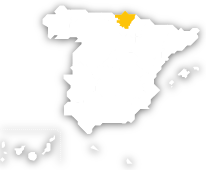With regards food, the Basque Country is probably the most important tourist destination in Spain. A coastal and border region, whose very varied culinary delights are due to the mixture of sea and mountain cultures with modern top-quality cooking. This trend emerged over the last decades with the appearance of the so-called Basque Nouvelle Cuisine. But most importantly, the good food is a reflection of the character of the Basque people, a people devoted to tradition and good food, the centre of any social occasion. The Basque Country, a culinary paradise
Due to its geographical position in the Bay of Biscay, the Basques have been avid sailors for many centuries. Its constant fishing on the shore of Terranova has resulted in the consumption of cod on mass. The cod is a fish which in the past was consumed on the mainland to fight off the famine and which today has been converted into a delicacy, forming part of numerous recipes. The sauces which have emerged due to this fish - "pil pil" (garlic), Biscay sauce, green sauce, "ajoarriero" (eggs and garlic) - have become real institutions over the years and are proof of the region's age-long capacity of producing sophisticated meals with the excellent raw materials at hand.
Fresh fish
Hake, bonito, red bream, spider crab, small cuttlefish, anchovies from Getaria or the very sought-after eels are other sea delicacies which are always present in the local cuisine and which are used to prepare seafood casseroles such as "marmitaco" and "zurrukutuna". Cuttlefish in ink and other local specialities such as barbels, which can be enjoyed in the popular dining-rooms of the fishing guilds in the small towns along the coast, tuna belly and sardines and red bream cooked on the griddle prove the Basque dexterity with regards cooking techniques. In the Basque Country, the griddle has become something of a ritual and is used for cooking both fish and beef. Those in the know ask for their enormous T-bone steaks or the local cut of beef known as "villagodio" to be cooked rare. The wild mushrooms known as "perretxikos" (especially the "boletus") and small game (pigeon, woodcock, turtledove...) are eaten during the months of Autumn, as are the local vegetables which have given rise to dishes such as stuffed peppers from Gernika or haricot beans from Tolosa.
Good desserts
The majority of traditional dishes are prepared using local products, which is logical in a mountain region with isolated hamlets and valleys. Many of the desserts are based on milk: deep fried custard slices, "mamía" (curdled sheep's milk with walnut sauce), "intxaursalsa" (milk pudding with cinnamon and walnuts), fried puff pastry rolls with custard, "pantxineta" (with liqueur), "franchipán" (with almonds), "sopa cana" (cinnamon and capon)... A piece of the famous idiazábal cheese is a must before tucking into a dessert. Apples are used to make the local cider. In one of the many cider bars found in the province of Gipuzkoa, the visitor can serve himself cider directly from the casks or "kupelas" and accompany the drink with a set menu comprised of cod omelette and T-bone steak served at large collective tables.
Wines and the pleasure of tapas
The other typically Basque drink is wine. It mustn't be forgotten that the Rioja Denomination of Origin lies to the south of the interior province of Álava, giving rise to a sub-zone called Rioja Alavesa where some of the oldest Rioja bodegas are found, such as Marqués de Riscal, next to more recent and innovative companies such as Artadi, which has gained international renown. Together with Rioja, the ultimate Basque aperitif which is served in local bars is the "txakoli" - a light, acid and aromatic white wine which is the perfect accompaniment to the famous "pintxos" (tapas). The very Spanish custom of going from bar to bar eating tapas is seen at its best in the Basque Country and has become an almost daily social ritual which all visitors must try. In traditional neighbourhoods such as the old quarter of the town called Donostia-San Sebastián, there is a line of bars all down the street and the locals go from one to another with their friends, tasting the different "pintxos" on offer at the bar. Another great Basque tradition with regards collective tables are the dining clubs or "txokos": these mainly male clubs were created during the middle of the nineteenth century and today, in Gipuzkoa alone, there exist more than 300 clubs where the members get together and cook, eat, drink and talk. It is a great honour to be invited to one of these meetings - an experience which shouldn't be missed if the opportunity presents itself.
Christmas food in the Basque Country
The Basque Christmas table is high recommended for lovers of fish and seafood. The txangurro (Basque-style spider crab) is a must-try and as a main course, the red bream or cod prepared with oil, garlic and peppers or pil-pil style. When it comes to the sweet section, there are two that are particularly famous, the intxaursaltsa (walnut cream) and goxua (a cake with custard, cream and sponge cake, the name of which means sweet or rich).


